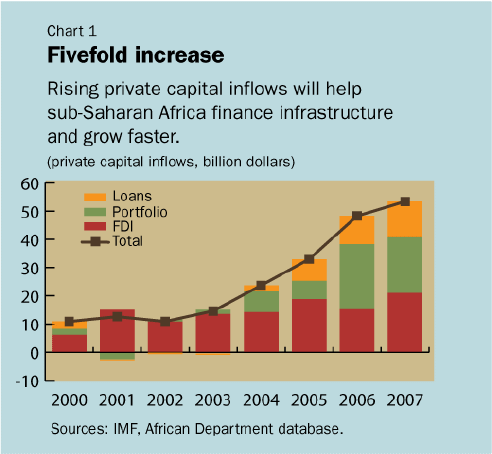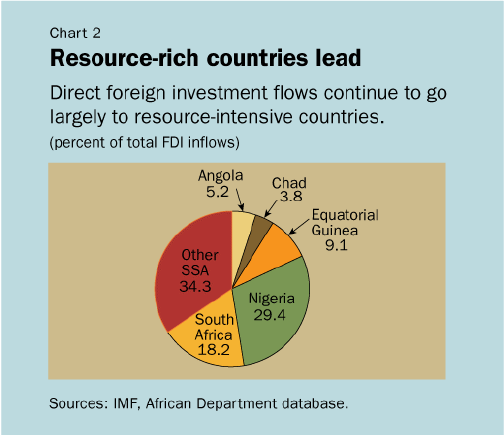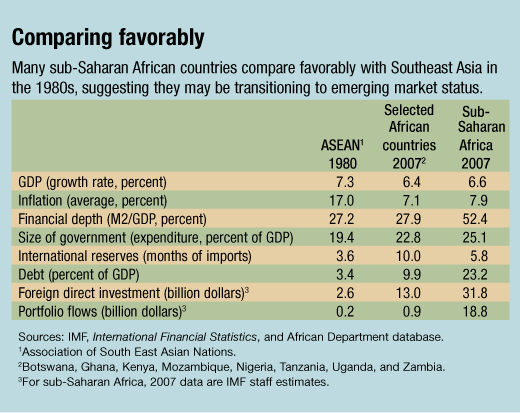
Typical street scene in Santa Ana, El Salvador. (Photo: iStock)
IMF Survey: Sub-Saharan Africa: Private Capital Fueling Growth
May 22, 2008
- Investors attracted by region's better macroeconomic performance
- Policymakers must guard against macroeconomic volatility, financial sector vulnerabilities
- Benefits of capital flows depend on better domestic institutions, stronger financial markets
Private capital flows to sub-Saharan Africa reached an estimated $50 billion in 2007, according to the IMF's latest outlook for the region.

A construction crew builds a new bridge on the Trans-Africa Highway near Tsavo National Park, Kenya (photo: Newscom).
REGIONAL ECONOMIC OUTLOOK
Although small compared with global capital flows, they overtook official aid flows for the first time in 2006 (see Chart 1).
Overall growth in sub-Saharan Africa (SSA) is expected to average about 6½ percent again this year, driven by oil exporters, while inflation in 2008 is projected at about 8½ percent, up from 7¼ in 2007, according to the report.
The rise in portfolio flows to the region has been particularly rapid. Although almost 90 percent of these went to South Africa, they are also on the rise in a small group of other countries—notably Ghana, Kenya, Tanzania, Uganda, and Zambia—in response to improved risk ratings and attractive yields.

Direct foreign investment flows continue to go largely to resource-intensive countries, led by Nigeria, although other countries are also benefiting (see Chart 2).

Emerging market status?
Abundant global liquidity is in part responsible for the surge of private capital flows into Africa. But investors are also attracted by sub-Saharan Africa's recent solid macroeconomic performance, more stable political situations, and high expected returns given surging commodity prices. Their interest is reflected in improved investment ratings, the renewed ability of some countries to tap international capital markets (Gabon, Ghana, and Seychelles have recently issued bonds internationally), and the growing number of private investment funds dedicated to SSA.
Rising portfolio flows into a small group of African countries with more developed financial markets suggest that these countries are transitioning to emerging market status. Indeed, many African countries compare favorably with east Asian countries in the 1980s (see table). However, the scale of the policy challenges and the environment for emerging markets in Africa are dramatically different.

Policy challenges of inflows
The acceleration of private capital flows into sub-Saharan Africa creates opportunities for the region, especially given that aid flows have remained unchanged in recent years. Private capital gives countries an alternative source of financing for infrastructure and other investments, thus stimulating growth and helping countries make progress toward achieving the Millennium Development Goals.
However, significant private capital inflows could increase macroeconomic volatility and build financial sector vulnerabilities, leading over time to real exchange rate appreciation and a loss of competitiveness. In Africa, private capital flows occur in the context of large export receipts stemming from higher commodity and oil prices (Cameroon, Ghana, Nigeria, Senegal, and Zambia) and scaled-up official inflows (Uganda and Tanzania), compounding the challenges for policymakers.
The current financial market turmoil also poses risks. So far, reversals of capital flows into sub-Saharan Africa have been modest and temporary. In South Africa, financial markets fell sharply during the summer 2007 but then recovered, reflecting more a reassessment of risks by foreign investors than massive withdrawals. In Kenya, the recent political crisis has had a temporary impact on capital inflows but has not caused any reversals. Solid fundamentals, including large foreign reserves, and thin and illiquid markets also help limit Africa's vulnerability to sudden reversals, though the situation may change as the global financial crisis continues to unfold.
Country-specific policy responses
African policymakers face particular constraints in responding to the policy challenges of capital inflows. In most cases, the lack of timely and accurate data has made it difficult for them to design an appropriate and effective policy response.
Their first challenge is to adapt monetary and exchange rate policies to the persistence of capital inflows. Uganda, Tanzania, and Zambia tried sterilized interventions—to counter undesirable exchange rate movements by altering their debt composition without affecting their monetary base. Sterilized interventions could help countries preserve exchange rate and monetary stability in the short term while allowing them to build up official reserves as insurance against sudden reversals.
However, this policy does not allow countries to reap the benefits of additional financing and is ineffective if the inflows are sustained. Unsterilized purchases of foreign exchange, which these countries tried next, increased the money supply and created inflationary pressures. Eventually, these countries had to allow more flexibility in their money and exchange rate targets.
Fiscal restraint can be effective in mitigating pressures on aggregate demand and the exchange rate. In Zambia, lower-than-budgeted public spending also helped. However, low-income countries' ability to use fiscal policy is limited because of their deep needs for social and infrastructure spending.
Capital account policies and government debt issuance strategies can help alleviate concerns about "hot" short-term portfolio inflows. Ghana was successful in limiting inflows of more volatile short-term capital through its design of capital controls, similar to those used by Chile in the 1990s. In Uganda and Zambia, the lengthening of maturities of government debt instruments made it possible to deepen the long end of the market and incidentally broaden the local investor base.
A look at tomorrow's agenda
Private capital flows are poised to replace official aid as the most important source of external finance for sub-Saharan Africa. This is a welcome development, but it puts a premium on sound macroeconomic management, transparent capital account policies, and financial sector reforms to ensure that countries use the inflows productively while avoiding macroeconomic instability and sudden reversals.
In the long run, the growth benefits of capital inflows depend on better domestic institutions and deeper and stronger financial markets. Countries in sub-Saharan Africa have already made significant progress toward these goals, and their efforts should continue to be rewarded.
Comments on this article should be sent to imfsurvey@imf.org


